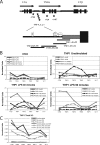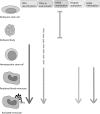Epigenetic regulation of tumor necrosis factor alpha
- PMID: 17515611
- PMCID: PMC1951949
- DOI: 10.1128/MCB.02429-06
Epigenetic regulation of tumor necrosis factor alpha
Abstract
Tumor necrosis factor alpha (TNF-alpha) is a potent cytokine which regulates inflammation via the induction of adhesion molecules and chemokine expression. Its expression is known to be regulated in a complex manner with transcription, message turnover, message splicing, translation, and protein cleavage from the cell surface all being independently regulated. This study examined both cell lines and primary cells to understand the developmental regulation of epigenetic changes at the TNF-alpha locus. We demonstrate that epigenetic modifications of the TNF-alpha locus occur both developmentally and in response to acute stimulation and, importantly, that they actively regulate expression. DNA demethylates early in development, beginning with the hematopoietic stem cell. The TNF-alpha locus migrates from heterochromatin to euchromatin in a progressive fashion, reaching euchromatin slightly later in differentiation. Finally, histone modifications characteristic of a transcriptionally competent gene occur with myeloid differentiation and progress with differentiation. Additional histone modifications characteristic of active gene expression are acquired with stimulation. In each case, manipulation of these epigenetic variables altered the ability of the cell to express TNF-alpha. These studies demonstrate the importance of epigenetic regulation in the control of TNF-alpha expression. These findings may have relevance for inflammatory disorders in which TNF-alpha is overproduced.
Figures










Similar articles
-
Histone acetylation and chromatin conformation are regulated separately at the TNF-alpha promoter in monocytes and macrophages.J Leukoc Biol. 2003 Jun;73(6):862-71. doi: 10.1189/jlb.1202618. J Leukoc Biol. 2003. PMID: 12773519
-
Epigenetic control of cytokine gene expression: regulation of the TNF/LT locus and T helper cell differentiation.Adv Immunol. 2013;118:37-128. doi: 10.1016/B978-0-12-407708-9.00002-9. Adv Immunol. 2013. PMID: 23683942 Free PMC article. Review.
-
Tumor necrosis factor-alpha inhibitors suppress CCL2 chemokine in monocytes via epigenetic modification.Mol Immunol. 2017 Mar;83:82-91. doi: 10.1016/j.molimm.2017.01.009. Epub 2017 Jan 21. Mol Immunol. 2017. PMID: 28113136
-
High histone acetylation and decreased polycomb repressive complex 2 member levels regulate gene specific transcriptional changes during early embryonic stem cell differentiation induced by retinoic acid.Stem Cells. 2007 Sep;25(9):2191-9. doi: 10.1634/stemcells.2007-0203. Epub 2007 May 24. Stem Cells. 2007. PMID: 17525233
-
Epigenetic landscape of amphetamine and methamphetamine addiction in rodents.Epigenetics. 2015;10(7):574-80. doi: 10.1080/15592294.2015.1055441. Epigenetics. 2015. PMID: 26023847 Free PMC article. Review.
Cited by
-
Targeting epigenetic regulators for inflammation: Mechanisms and intervention therapy.MedComm (2020). 2022 Sep 15;3(4):e173. doi: 10.1002/mco2.173. eCollection 2022 Dec. MedComm (2020). 2022. PMID: 36176733 Free PMC article. Review.
-
Immune senescence, epigenetics and autoimmunity.Clin Immunol. 2018 Nov;196:59-63. doi: 10.1016/j.clim.2018.04.002. Epub 2018 Apr 11. Clin Immunol. 2018. PMID: 29654845 Free PMC article. Review.
-
Dual transcriptome sequencing reveals resistance of TLR4 ligand-activated bone marrow-derived macrophages to inflammation mediated by the BET inhibitor JQ1.Sci Rep. 2015 Nov 19;5:16932. doi: 10.1038/srep16932. Sci Rep. 2015. PMID: 26582142 Free PMC article.
-
Pregnancy associated epigenetic markers of inflammation predict depression and anxiety symptoms in response to discrimination.Neurobiol Stress. 2020 Nov 21;13:100273. doi: 10.1016/j.ynstr.2020.100273. eCollection 2020 Nov. Neurobiol Stress. 2020. PMID: 33344726 Free PMC article.
-
The role of miR-19b in the inhibition of endothelial cell apoptosis and its relationship with coronary artery disease.Sci Rep. 2015 Oct 13;5:15132. doi: 10.1038/srep15132. Sci Rep. 2015. PMID: 26459935 Free PMC article.
References
-
- Amour, A., P. M. Slocombe, A. Webster, M. Butler, C. G. Knight, B. J. Smith, P. E. Stephens, C. Shelley, M. Hutton, V. Knauper, A. J. Docherty, and G. Murphy. 1998. TNF-alpha converting enzyme (TACE) is inhibited by TIMP-3. FEBS Lett. 435:39-44. - PubMed
-
- Armenante, F., M. Merola, A. Furia, and M. Palmieri. 1999. Repression of the IL-6 gene is associated with hypermethylation. Biochem. Biophys. Res. Commun. 258:644-647. - PubMed
-
- Askling, J., M. Fored, E. Baecklund, L. Brandt, C. Backlin, A. Ekbom, C. Sundstrom, L. Bertilsson, L. Coster, P. Geborek, L. Jacobsson, S. Lindblad, J. Lysholm, S. Rantapaa-Dahlqvist, T. Saxne, L. Klareskog, and N. Feltelius. 2005. Hematopoietic malignancies in rheumatoid arthritis. Lymphoma risk and characteristics following TNF-antagonists. Ann. Rheum. Dis. 64:1414-1420. (First published 20 April 2005; doi:10.1136/ard.2004.033241.) - DOI - PMC - PubMed
-
- Barthel, R., and A. E. Goldfeld. 2003. T cell-specific expression of the human TNF-alpha gene involves a functional and highly conserved chromatin signature in intron 3. J. Immunol. 171:3612-3619. - PubMed
Publication types
MeSH terms
Substances
Grants and funding
LinkOut - more resources
Full Text Sources
